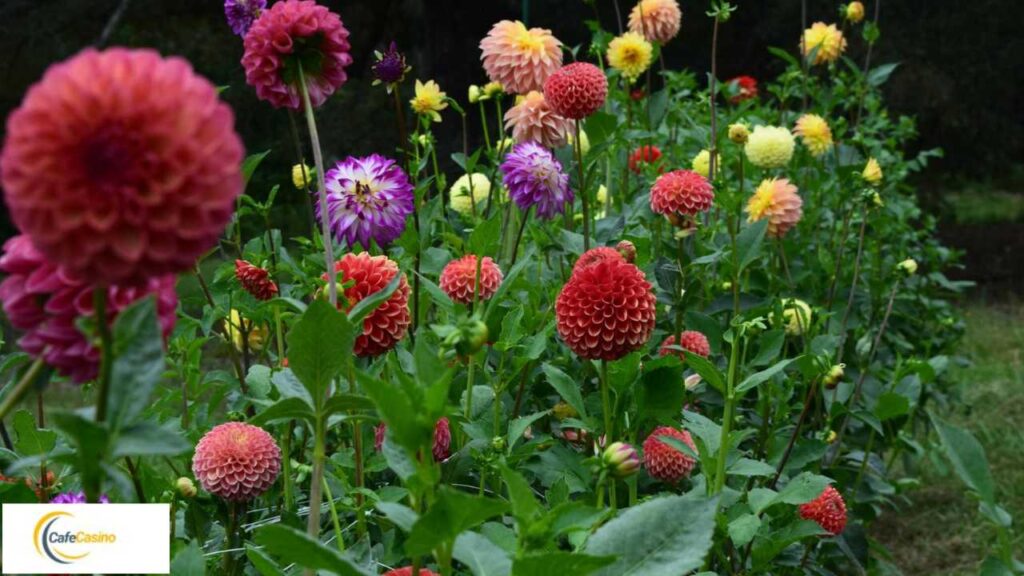Dahlias’ stunning array of colours and forms captivate gardeners and flower enthusiasts alike. However, their beauty often belies their challenges, from understanding the right planting conditions to ensuring they thrive across seasons.
Fortunately, growing dahlias successfully is achievable with the proper knowledge and techniques. From choosing the correct tubers to mastering the care they need throughout the year, I will guide you through every step to ensure your dahlias bloom spectacularly.
Dive into the rest of this article to unlock the secrets of cultivating these breathtaking flowers in your garden. Whether a novice or a seasoned gardener, you’ll find valuable insights and tips to enhance your gardening experience and fill your space with vibrant colours.
Understanding Dahlias
Dahlias are not just any flower; they’re a diverse group of flowering plants known for their stunning beauty and variety. They belong to the Asteraceae family, which includes daisies and sunflowers. Dahlias can be the centrepiece of any garden in their range of sizes, colours, and shapes. Growing dahlias requires specific know-how, especially when choosing the suitable species and understanding their care requirements.
Botanical Profile of Dahlias
Dahlias are characterized by their tuberous roots, which store energy for the plant to thrive and bloom. These roots enable the plant to survive winter in colder climates, provided they are adequately cared for. The stems of dahlias are hollow and leafy, supporting the heavy blooms ranging from 2 inches to over a foot across in some “dinner plate” varieties. The leaves are typically green, but some varieties feature unique hues, adding to their visual appeal.
Species and Classifications
At least 42 species of dahlias and thousands of cultivars resulting from extensive hybridization exist. This diversity has led to the classification of dahlias into several groups based on the shape and size of their flowers, including cactus, ball, decorative, and peony-flowered. Each type offers different colours and sizes, making dahlias a versatile choice for gardeners and floral designers.
Historical Significance
The history of dahlias is as colourful as the flowers themselves. Native to Mexico, they were initially grown as a food crop by the Aztecs but later became a powerhouse in the gardening world due to their vibrant blooms. Introduced to Europe in the late 18th century, dahlias quickly became famous for their beauty and variety.
The Story of the Black Dahlia
The term “Black Dahlia” was famously used as a nickname for Elizabeth Short, a woman tragically murdered in Los Angeles in 1947, in a case that captured the public’s imagination and remains unsolved. The nickname is thought to have been derived from her rumoured fondness for wearing black clothing and the popularity of the film “The Blue Dahlia,” released shortly before her death. This story, though starkly contrasting with the flower’s beauty, has contributed to the mystique and notoriety surrounding the name “Black Dahlia.”
Also Read: The Ultimate Guide to Aiyifan: Origins, Uses, and More
Preparing to Plant Dahlias
Before you plant dahlias, it’s essential to understand the conditions they thrive in. Dahlias bloom beautifully when given the right start. This section covers everything you need to know about setting up your dahlia garden, from soil preparation to the best planting times.
Optimal Conditions for Growing Dahlias
Dahlias flourish in environments that mimic their native habitats. They require a balance of sunlight, soil conditions, and climate to produce their large, colourful blooms.
Soil, Sunlight, and Climate Needs
Dahlias need well-draining soil to prevent rot, and they love the sun. Aim for a spot that gets at least six hours of sunlight daily. While they prefer a moderate climate, dahlias are adaptable but do not fare well in extreme cold without protection. The ideal soil pH for dahlias is slightly acidic to neutral, around 6.0 to 7.0.
When to Plant Dahlias
The timing of planting dahlias is crucial for their development and blooming phase. Understanding when to start can make a significant difference in your gardening success.
Timing and Seasonal Tips
Plant dahlia tubers in the spring after all danger of frost has passed and the soil has warmed up. This is usually around the same time you would plant tomatoes. In cooler climates, you can start tubers indoors to get a jump on the season.
Planting Techniques
Planting dahlias correctly ensures they grow and bloom to their full potential. Here, we’ll review the techniques and considerations that can help your dahlias thrive.
How to Plant Dahlia Tubers?
Choosing the right spot and correctly planting the tubers are fundamental steps that affect the health and flowering of dahlias.
Step-by-Step Planting Guide
- Choose the Right Location: Pick a sunny spot with good drainage.
- Prepare the soil: Loosen the soil and mix it in compost or manure to improve fertility.
- Planting Depth and Spacing: Plant tubers about 4-6 inches deep with the eye (the point where the new growth starts) facing up. Space them about 2-3 feet apart to give each plant enough room to grow.
- Watering: After planting, water the tubers lightly to settle the soil around them. Avoid overwatering, as this can cause the tubers to rot.
Starting Dahlias Indoors
For gardeners in cooler climates, starting dahlias indoors can give them a head start on the growing season.
Early Growth Techniques
- Potting Up Tubers: Using a high-quality potting mix, potting tubers in large containers with drainage holes.
- Light and Temperature: Place the containers in a warm, bright area but out of direct sunlight until sprouts appear.
- Watering: Keep the soil moist but not waterlogged. Overwatering can damage the tubers.
- Acclimating to Outdoors: Once the danger of frost has passed and the plants have sprouted, begin to acclimate them outdoors gradually before planting them in the garden.
Following these detailed steps will ensure that your dahlias are set up for success and will result in a lush, vibrant garden.
Also Read: TouchCric – Your Ultimate Guide to Live Cricket Scores
Dahlia Care and Maintenance
Proper care and maintenance are essential for dahlias to thrive and produce stunning blooms. This section will cover everything from watering and feeding to protecting your dahlias from common pests and diseases.
Watering and Feeding Your Dahlias
Dahlias require consistent moisture to flourish, especially during the growing season. However, avoiding overwatering is essential, as this can lead to root rot.
Best Practices for Dahlia Care
- Watering: Provide a deep watering 2-3 times a week rather than frequent shallow watering. This helps encourage more profound root growth.
- Feeding: Use a low-nitrogen fertilizer every 3-4 weeks, starting about a month after planting. High phosphorus content is beneficial as it encourages blooming.
Protecting Dahlias from Pests and Diseases
Dahlias can attract several pests and be affected by various diseases. Early detection and proper management are crucial to keeping your plants healthy.
Common Threats and Solutions
- Pests: Slugs, snails, and aphids are common. Use environmentally friendly pest control like diatomaceous earth for slugs and neem oil for aphids.
- Diseases: Powdery mildew and botrytis are the most common fungal diseases. Ensure good air circulation around plants and treat them with fungicides if necessary.
Cultivating Dahlias Successfully
Understanding whether dahlias are perennials or annuals in your climate, along with other cultivation tips, can enhance your gardening experience and help you get the most out of your dahlias.
Are Dahlias Perennials or Annuals?
Dahlias are technically perennials, but their ability to return yearly depends on the climate.
Understanding Their Lifespan in Different Zones
In USDA zones eight and above, dahlias can generally survive the winter in the ground with appropriate mulch. In colder zones, they should be treated as annuals or dug up and stored during winter.
Techniques for Prolonging Bloom Time
Specific techniques can be very effective certain methods can be very effective in maximizing the blooming purest.
Pruning and Deadheading
- Pruning: When your dahlia plants reach about 16 inches tall, pinch the growing tip above the fifth pair of leaves to encourage bushier growth and more flowers.
- Deadheading: Regularly remove spent flowers to prevent the plant from going to seed. This encourages continued blooming.
Particular Focus: Growing Dahlias from Tubers
Starting dahlias from tubers is a rewarding way to cultivate these beautiful flowers, as it allows for greater control over the growing conditions from the very start.
Detailed Guide on Dahlia Tubers
Dahlia tubers are the key to growing robust plants. Select healthy, disease-free tubers and ensure they have visible “eyes” or growth points.
From Storage to Sprouting
- Storage: Keep tubers in a cool, dry place over winter. Avoid areas that are too damp or too dry.
- Sprouting: Before planting, allow the tubers to warm up and sprout in a bright, airy location. This pre-sprouting can give your dahlias a head start on the growing season.
Also Read: // Zerodevice.net Latest In Wearable Tech Guide
(FAQ)
When to Plant Dahlia Tubers?
Dahlia tubers should be planted in the spring after all danger of frost has passed and the soil has warmed. This typically means waiting until the ground temperature reaches about 60°F. For most regions, this is usually the same time you would plant tomatoes, around late April to early May.
How to Grow Dahlias from Tubers?
To grow dahlias from tubers:
- Start by selecting a sunny location with well-draining soil.
- Plant the tubers about 4-6 inches deep with the “eyes” or growth points facing up.
- Space them about 2-3 feet apart for adequate air circulation and growth.
- Water the tubers lightly after planting and wait for sprouts to appear before increasing the watering frequency.
Are Dahlias Perennials?
Dahlias are technically perennials, but their ability to return yearly depends on the climate. Dahlias can generally overwinter the ground with proper mulching in USDA hardiness zones eight and higher. They are often treated as annuals in cooler zones unless the tubers are dug up in the fall and stored indoors during winter.
Concluding Thoughts
Why Grow Dahlias?
Dahlias are among the most versatile and spectacular flowers you can grow in your garden. They offer various colours and sizes, ensuring a variety to suit every taste and garden design.
Benefits and Aesthetic Value
Growing dahlias can transform your garden space into a vibrant tapestry of colours. These flowers enhance the beauty of your surroundings and attract pollinators like bees and butterflies, which are vital for a healthy garden. Additionally, dahlias are excellent for cut flowers, allowing you to bring their beauty indoors.
Share Your Dahlia Stories
I’d love to hear about your experiences growing dahlias, whether you’re a seasoned gardener or a beginner. Your stories are valuable.
Tips, Photos, and Questions
Please share any tips you have for growing dahlias and photos of your dahlias in bloom. If you have questions or need advice, feel free to ask. Let’s create a community where we can all learn and enjoy the beauty of dahlias together!



